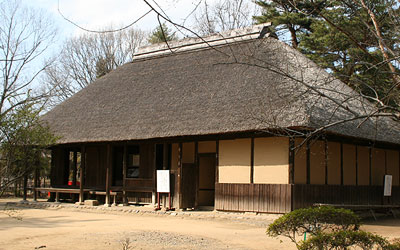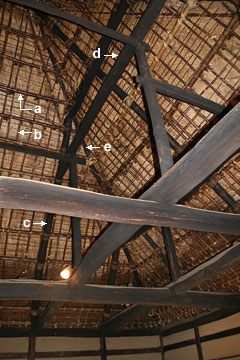Also *kayabuki yane 茅葺屋根. Lit. thatching with miscanthus. However, the word *kaya 茅 includes the use of many kinds of grasses, reeds and straw. Although thatched roofs are usually associated with vernacular dwellings *minka 民家, some shrine or temple buildings or gates still use this type of roofing material. Thatch roofs last a maximum of about 30 years, before thatching becomes necessary. About half the thatch can be removed, dried out and reused. Today there is a scarcity of skilled thatchers. Thatched roofs have also always been a fire hazard the use of thatched roofs has decreased exceedingly. The shape and pitch of thatched roofs vary from region to region. The steepest roofs use the gasshou style *gasshou-zukuri 合掌造, to shed snow easily while in milder areas the pitch used is relatively gentle. A thatched roof requires first, the erection of a simple, basic framework or roof truss that consists of short struts called *nokigeta 軒桁 and kirisasu 切扠首, which are needed to support the kabutogeta 兜桁, a horizontal beam attached to the hip rafters *sumigi 隅木. Each end of the ridge *munagi 棟木, is affixed to the peak of the hip rafters. The framework is set at the required intervals between the gable ends to carry the ridge. Long lengths of strong, large bamboo *yanakadake 屋中竹, are laid like purlins about 30cm apart. Next, bamboo rafters hirasasu 平扠首, which have a slightly smaller diameter than the yanakadake, are set at close intervals. Their number varies with the size of the roof. Between the rafters are several *tarukidake 垂木竹 or *etsuridake 桟竹, small bamboo rafters extending from ridge to the eave purlin. Split bamboo is positioned and tied horizontally about 15 cm apart. Thatching begins at the eave ends. Tied bundles of thickly thatched miscanthus kaya ; or in coastal regions where available, ditch reed yoshi 葭, is used. Ditch reed is considered more durable than miscanthus or other grasses, and is therefore used for the eave ends. The thatch is held in place with small bamboo pegs, about 30cm long, called shinodake 篠竹 or hokodake 鉾竹. These are pounded into the inclined members of the underlying framework, to which the thatch may also be tied as each layer is applied. The bamboo pegs also help to prevent slippage of the thatch. Sometimes short bamboo lengths that project forward a little are tied vertically to these pegs. This method is called tenbin 天秤. On the upper tips of the pegs, horizontally positioned bamboos are tied creating an added place for tying the thatch. The eave ends of thatched roofs are built up so that the thatch may be 90cm thick or more. In ordinary thatching hirabuki 平葺, the miscanthus or ditch reed may be piled up. Without the proper trimming of the rotund parts, the characteristic beauty of a thatched roof would vanish. Sometimes the knots of rope used for tying are too close to the top, and therefore, decay quickly. When the roof is well constructed, a template is made and used on the framework to mark the position of knot tying. The thickness of the thatch, except at the eave ends, is usually about 35cm. If the incline of a thatched roof is too gentle, it will also decay easily. Therefore, the incline called tankoubai 短勾配, varies from about 15cm to 21cm. When thatch is laid at the ridge, the last row of miscanthus is bent upward and then more thatch is placed at right angle to the ridge across its very top. The treatment of the ridge varies from region to region. Sometimes it is covered with the bark of cedar, tile, clay or boards held in place by inclined wooden strips that cross at the peak. Sometimes a long pole is held inside these crossed strips and thatch is formed into a semi-circular roll covered by bark and held by horizontal wooden slats. A thatched roof is finished when it has been trimmed with very large scissors from top to eave. In some areas, it is pounded with a battledore instead. Sometimes the roof framework in a shrine building has log rafters with squared off ends, four sides with the bark left at the corners. These are called oshigaku 押角.
|


